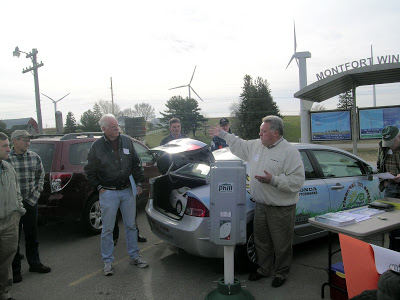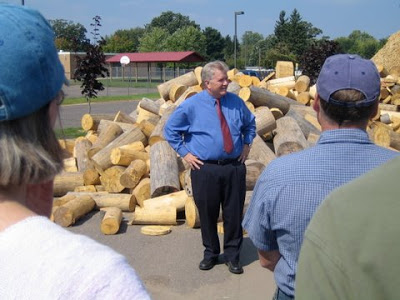by jboullion | Dec 3, 2009 | Uncategorized
From a news release issued by Kohl’s Corporation:
MENOMONEE FALLS, Wis., December 2, 2009 – Kohl’s Department Stores (NYSE: KSS) today became the first retailer to announce a commitment to reach net zero U.S. greenhouse gas emissions as part of its ongoing partnership with the U.S. Environmental Protection Agency’s (EPA’s) Climate Leaders program. To achieve this goal of being carbon neutral, Kohl’s will continue to invest in projects to reduce the same amount of greenhouse gas emissions that the company emits into the atmosphere.
The goal accounts for U.S. emissions at all Kohl’s facilities, including stores, distribution centers and corporate offices, as well as emissions resulting from business travel. Kohl’s goal, once realized, will be equivalent to removing more than 130,842 vehicles from the road for a year or offsetting the annual emissions from electricity used by more than 99,084 homes. . . .
Initiatives central to Kohl’s achievement of its Climate Leaders goal include a continuation of the company’s five environmental strategies: maximize energy efficiency, minimize waste, improve new building design, reduce emissions and encourage environmental values. Highlights include:
• Commitment to green power: Kohl’s strongly supports the development of renewable energy and was named one of EPA’s 2009 Green Power Partners of the Year. The company currently ranks as the no. 1 retailer on EPA’s list of Green Power Purchasers in its Green Power Partnership. In 2009, Kohl’s purchased 851 million kilowatt-hours in renewable energy credits – enough to meet 71 percent of the company’s purchased electricity use. Kohl’s plans to reach 100 percent green power by the end of 2010.
• Leading solar program: Kohl’s is currently the world’s largest retail host of solar power with 79 solar locations in six states – California, Wisconsin, Oregon, Connecticut, Maryland and New Jersey. The company aims to expand the program into additional states in 2010 to reach more than 100 solar locations.
• Central Energy Management Systems: As of 2008, all Kohl’s locations are operated by a system that controls most interior and exterior lighting, as well as heating and cooling systems. Last year, even while adding more than one million square feet of retail space through new and existing store expansion, Kohl’s reduced its greenhouse gas emissions by 12 percent.
• ENERGY STAR: The EPA ENERGY STAR national energy performance rating system provides a score on a 1 to 100 scale relative to similar buildings nationwide, with 50 as the average score. Buildings with a score of 75 or higher are eligible to receive EPA’s ENERGY STAR label. To date, more than 350 Kohl’s stores have earned the ENERGY STAR label – this is more than one third of all Kohl’s stores and more than 70 percent of retail buildings to date that have earned the ENERGY STAR. As a whole, Kohl’s stores average an ENERGY STAR score of 72, well above industry standard.
by jboullion | Nov 20, 2009 | Uncategorized
From an article by Chad Dally in The Daily Press (Ashland):
Six municipalities, one transit system and more than seven million kilowatt hours of electricity consumed.
That is one of many initial discoveries of local government officials, the Alliance for Sustainability and others through a Wisconsin Energy Independent Communities pilot project.
The Chequamegon Bay region was one of 10 communities — and the largest of the 10 — that took part in the pilot project, which in the first phase attempted to pin down a baseline assessment on energy and fuel consumption for the past three years. The initiative is one of the first steps in Wisconsin’s 25 x 25 Plan, which set a goal of generating 25 percent of the state’s energy and transportation fuel from renewable sources by 2025. Also included is the goal of securing 10 percent of the nation’s emerging bio-industry jobs within Wisconsin. Generating more alternative and renewable energy and fuel within the state and especially within the Chequamegon Bay region has huge implications, since Wisconsin spent more than $21 billion on energy in 2007.

by jboullion | Nov 16, 2009 | Uncategorized
 Standing behind an electrical vehicle charger at the beginning of the Homegrown Renewable Energy tour, Tom Shee, Honda Motorwerks, La Crosse, explains that the electricity from the turbines at the Monfort Wind Farm could provide the power for the plug-in hybrid behind him. Photo by Laura Stoesz.
Standing behind an electrical vehicle charger at the beginning of the Homegrown Renewable Energy tour, Tom Shee, Honda Motorwerks, La Crosse, explains that the electricity from the turbines at the Monfort Wind Farm could provide the power for the plug-in hybrid behind him. Photo by Laura Stoesz.
by jboullion | Sep 18, 2009 | Uncategorized
From a post by Craig McCarthy on Mequon Now:
A workshop on fuel economy takes place at Concordia University Wisconsin on September 18th and 19th. The event is entitled, 35.5: Your Target MPG, and will include presentations and panel discussions on energy independence.
One of the highlights of the two-day event will be energy efficient vehicles, like the Smart Car and the Toyota Prius, displayed around Concordia’s Mequon campus. The American Lung Association will show off their Bio-fuel vehicle and members of the Milwaukee Hybrid Group will be on hand to talk with people about the important role hybrids are playing in achieving fuel efficiency.
“The goal of the symposium is to challenge people’s thinking about how our country can use less fuel,” said Dr. Lawrence Sohn, Interim Sustainability Coordinator at CUW. “Students, staff, faculty, and the community will not only view energy efficient vehicles during this event, they will get useful information that will help them drive and live more fuel efficient,” Sohn added.
“Fuel economy is a primary area in which the average citizen can easily make a significant impact, decreasing our dependence on fossil fuels, particularly from foreign sources,” indicated Prof. Bruce Bessert, Director of the Concordia Center for Environmental Stewardship. It also promotes the use of renewable energy sources while, at the same time, saving money in a tight economy,” he added. . . .
For more information on this event log onto, www.cuw.edu or visit http://energy.cuw.edu

by jboullion | Sep 15, 2009 | Uncategorized

From a post by Margaret Krome in The Capital Times:
At Farm Progress Days this summer, other farmers told me that they also are interested in creating solar or wind energy, but their decision hinges on whether they receive a sufficient payback on their investment. The rapid and extensive growth of renewable energies in Germany, Denmark and parts of Canada is attributed overwhelmingly to a single policy addressing this concern, called “feed-in tariffs.” (In Europe, the word “tariff” can mean “price.”) This policy encourages small businesses, households, farms, towns – anyone – to produce renewable energy by providing a stable price for that energy at a rate that considers the actual costs of producing it. It’s an obvious idea, but currently in most parts of the United States, utilities set widely varying rates for renewable energy – rates that seldom properly calculate the costs of producing it.
Wisconsin policymakers are on the verge of considering this and other policies to support renewable energy. Last week I joined the Homegrown Renewable Energy Campaign bus tour of four sites in northwest Wisconsin that illustrate ways communities and entrepreneurs can benefit from those policies.
We visited the bus garage for the Cadott School District, which converted its bus engines two decades ago to use compressed natural gas, which cut up to two-thirds off the district’s transportation costs.
We saw a small electric vehicle whose manufacturer is located in Wisconsin and may be one of the few vehicle manufacturers with growing, not shrinking, demand.
Pete Taglia, a scientist with Clean Wisconsin, explained how one policy under consideration, a low carbon fuel standard, would set a market standard for energy sources with a lower lifetime carbon footprint, rewarding fuel manufacturers, distributors, and ultimately users.
We visited Barron High School, which for over 20 years has been heated – and now is also cooled – by burning wood chips. A fuels for schools policy would help other schools use nearby biomass similarly.
We also saw biomass research plots at the University of Wisconsin’s Spooner research station. A proposed biomass crop reserve program would reward farmers for taking land that’s vulnerable to soil erosion and planting it to longer-term and less-erosive biomass crops.
Wisconsin would be wise to support homegrown renewable energy. Avoiding fossil fuels can help reduce climate change. Renewable energy projects offer many opportunities to build new jobs. And, as Valerie Adamski said, “It’s nice not to be in the hands of a foreign oil company.”


